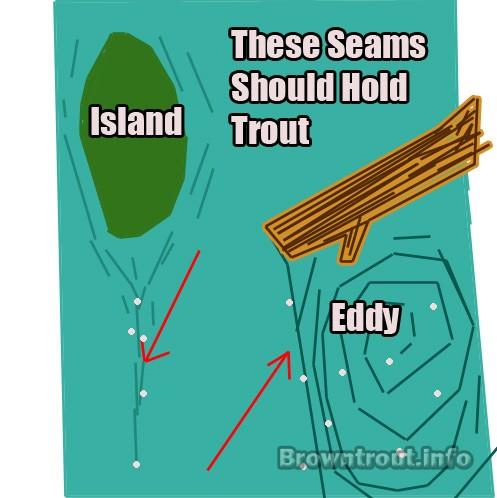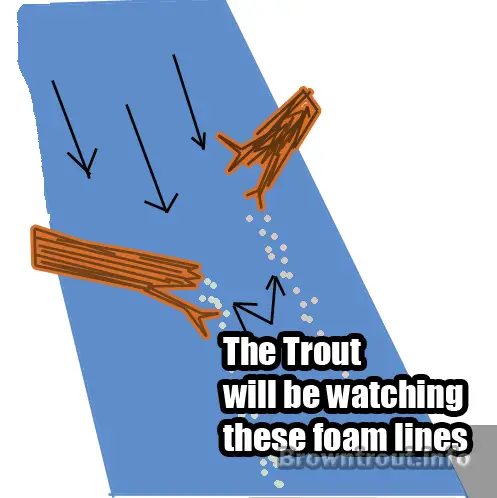This post was last updated on July 30th, 2021 at 10:49 am
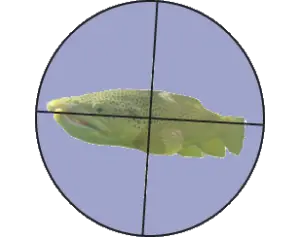
When it comes to how to fly fish a river for trout, there’s a lot to consider. You will likely have heard people talk about fishing the Foam while river fly fishing, but what does that mean? Here I will explain and also tell you about a few other key areas where trout will hold. By learning the locations of the trout, you will certainly increase your catch rate. You should easily be able to analyze the stream and determine the most likely areas where the fish are sitting. Read on to learn more about how to fly fish a river for trout.
Fly Fishing The Foam For Trout
The foam is merely bubbles in the river that are caused by various currents. You can easily determine the trout locations by watching where the foam is going and looking for areas where it is concentrated or funneled. The trout will watch these specific areas for a very good reason, and the largest trout in a run or riffle will most often be found in these areas.
Notice the foam in the picture left. It is concentrated in narrow strips after it comes in contact with the two logs. These areas are effective trout holding areas, not only because they concentrate the foam, but the insects as well. The foam and bubbles will be a red flag indicator that various insects will be floating along with it. As the current flows down river it will “funnel” most of the surface water into certain areas, within these areas will be a large supply of floating insects that the trout will be waiting for. This is a universal indicator of a good fly fishing spot. There are also other areas where you will find foam lines and “seams” that will hold large quantities of trout such as the convergence of two river channels.
Fly Fishing the Seams in the River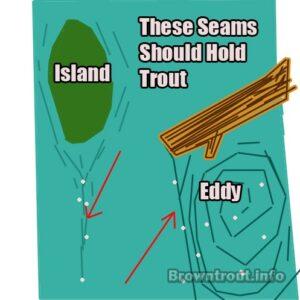
Where Two river channels or currents converge is called a seam. These are easy to identify and will usually hold fish. You will find these areas to often also include foam and they will indeed contain insects that the trout are waiting for. To Identify a seam you will be able to see a visible line in the water that indicates the two separate currents coming together. In these separate currents converging they are concentrating all of the insects. The insects will not only be on the surface but below as well. These would be two great areas to try nymphing as well as dry fly fishing for trout.
Any time you see two currents coming together or the accumulation of foam you are likely looking at a good fly fishing area. Keep these in mind during every cast throughout the day and you will likely catch a whole lot more fish. There are of course times where fish will be found in riffles and pools with no visible foam lines or seams.
Fishing Riffle Water
While fishing in Riffles you might not have any visible seams, if this is the case you should systematically fish the entire riffle. You will likely find that the largest fish will prefer either the very top of the riffle, or the lowest area where it will possibly drop off into deeper water. These areas will allow two things for the trout:
- The lower end of the riffle will allow quick access to deep water in case of a predator coming.
- The highest spot in the riffle will give the biggest fish the first shot at all of the available food floating down.
By carefully starting at the lowest end of the riffle water and fishing your way toward the top, you will be able to hopefully catch most of the active feeding fish within.
Riffle Fishing Tips
Move slowly and carefully, make sure you hit all of the water in the riffle. These fish are sitting here to often intercept hatching insects, so the fish could be sitting almost anywhere in them. It also might take the fish a few drifts to even see your fly floating by, so cast multiple times to each area. Riffles are often fast and it would be easy for a fish to not see your fly the first couple drifts.
Identifying the Best Areas for River Fishing – Trout Holding Areas
The red bulls eyes below show the high probability areas for hooking trout. See the full outline below.
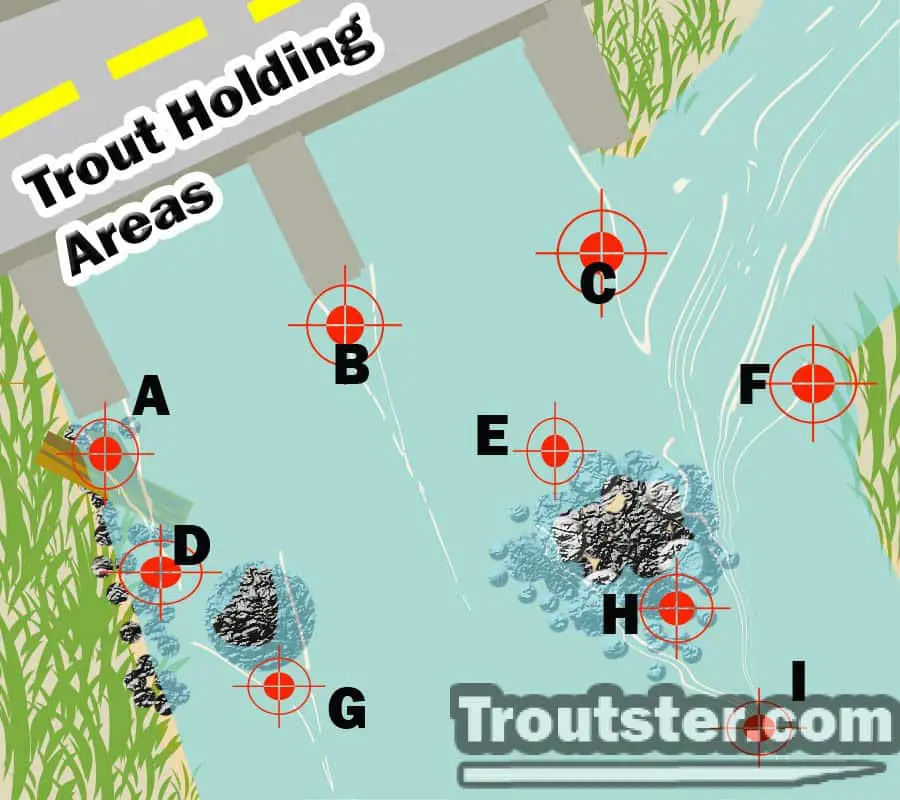
You likely won’t find too many areas like this loaded with this much quality habitat, but this should help you learn to identify trout fishing holding zones. Even one of these small examples in a section of river should have fish.
A). This location would be a slam dunk. On the downstream side of this bridge piling would have a small eddy with insects collecting. The seam flowing off the piling would also have a steady supply of food floating past any waiting trout. The log shown in this area would be the icing on the cake. In a real fishing situation there would indeed be a fish sitting in this spot.
B). Similar to spot A, this bridge piling would also have fish resting in the slower currents behind it. They would watch the seam where the 2 currents come back together. A high potential to catch trout here if you could pull off the tricky drift.
C). As you can see, this location is the convergence of a small creek and the main river. On the seam where these two rivers meet would be a string of insects for food. It would be almost a certainty that trout would be sitting here.
D). The fish in this spot would be enjoying all sorts of benefits. They could watch the seam flowing off the bridge piling, rest in the slightly slower water created by the large rock and feed on insects on the rocky bank.
E). Similar to spot (D) the fish here would have slightly slower currents, because of the rock slowing it’s momentum. This would likely create a small area of slack water close to the upstream side of this rock. Insects would be easy targets for trout here.
F). This small grassy point would offer easy food for trout. They would be resting close to the bank in a small eddy, watching the current at the bottom of the feeder creek as the water meets the main river. I would expect to catch more than one fish here.
G). The lower end of this rock would clearly offer a nice place to rest in mild current and offer easy meals for the trout in the swirling current.
H). Trout should be piled up like cord wood in this spot. They would be watching the remainder of the creek/main river seam while enjoying the mild current created by the rock pile just up stream. I would fish this spot hard, because within this small area is nearly everything a river trout could ask for.
I). This is pretty much whats left over from spot (H). Not only is there the last bit of seam from the creek coming into the main river, but another set of converging currents created from the rock pile. You could likely catch fish for a long ways downstream in this particular current line.

